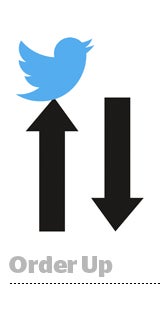Twitter’s giving its reverse chronological timeline an algorithmic tweak.
Rather than automatically seeing the most recent tweets first and then moving backward in time as they scroll, starting Wednesday users will see a curated lineup of roughly one dozen tweets at the top of their timeline culled from the accounts they follow.
To determine which tweets to surface at the top of timeline, Twitter will analyze real-time data around the type of content users engage with most often, their particular topics of interests, what they’re likely to click on and the activity of similar users. Twitter’s traditional reverse chronological timeline will then resume below the cherry-picked tweets.
The rollout won’t impact the way Twitter’s ad products like Promoted Tweets and Promoted Accounts are displayed.
“So much is happening on Twitter every day and sometimes it’s easy for people to miss great content,” said Ameet Ranadive, Twitter’s VP of revenue products. “Previously, we constructed the user timeline with recency as the only factor, and now we’re adding relevance to make sure the best and most timely tweets get shown.”
The news isn’t wholly unexpected. There was a lot of recent speculation around the nature Twitter’s timeline-related plans and also a great deal of ire at the proposition of losing reverse chronologically ordered tweets.
But Ranadive stressed that it’s up to users whether they pull the trigger. Users will have the option to turn the feature on or off in their settings.
Mainly, this is a consumer enhancement more than an advertising play, although there are implications for advertisers, Ranadive said.
Although Twitter has been accused of copying Facebook in a number of different ways – from expanded character limits to autoplay video to the algorithmic timeline – one clear distinction is Twitter’s support of organic content. Facebook’s algorithm notoriously prefers paid content.
 “Unlike other platforms, all content on Twitter is created equally, which reinforces that this is not a pay to play algorithm,” Ranadive said. “The best content, whether it’s from a celebrity or another user or a brand is what rises to the top.”
“Unlike other platforms, all content on Twitter is created equally, which reinforces that this is not a pay to play algorithm,” Ranadive said. “The best content, whether it’s from a celebrity or another user or a brand is what rises to the top.”
In essence, the revamped timeline is an expansion of Twitter’s “While You Were Away” feature, which shows users who haven’t used the app for a while a handful of the “best tweets” they might have missed during their absence.
It’s also an attempt to engage new users – and investors have been skeptical about Twitter’s ability to do so. Wall Street has accused Twitter of being more difficult to use than other social platforms.
CEO Jack Dorsey has acceded the point on previous earnings calls, noting in Q3 that the product road map is centered on “iterations that continue to make Twitter easier to understand and make it far more approachable than it has been in the past.”
The release of Moments was an attempt in a similar vein. The feature, rolled out in October, collects trending tweets into more easily digestible bundles for the Twitter uninitiated. But some power users have balked at what seems like a departure from the core real-time nature of Twitter’s platform.
It’s a rock-and-hardplace situation, and Twitter is perched in between.
“Twitter needs a sure hit to keep marketers interested,” Forrester analyst Erna Alfred Liousas told AdExchanger in a previous interview. “That means reaching new users and making sure that existing users are engaged, and Twitter seems a little fuzzy on how to do that.”
In other Twitter timeline-related news, the company launched a product on Tuesday called First View, a prominently placed video ad unit that sits between the first and third tweets in a user’s feed. Basically, advertisers will be able to buy the space on an exclusive basis for a 24-hour period – essentially an in-feed takeover that shows up every time a user opens the app or checks out the desktop site.
Twitter reports its fourth-quarter earnings today at 5 p.m. Eastern.















